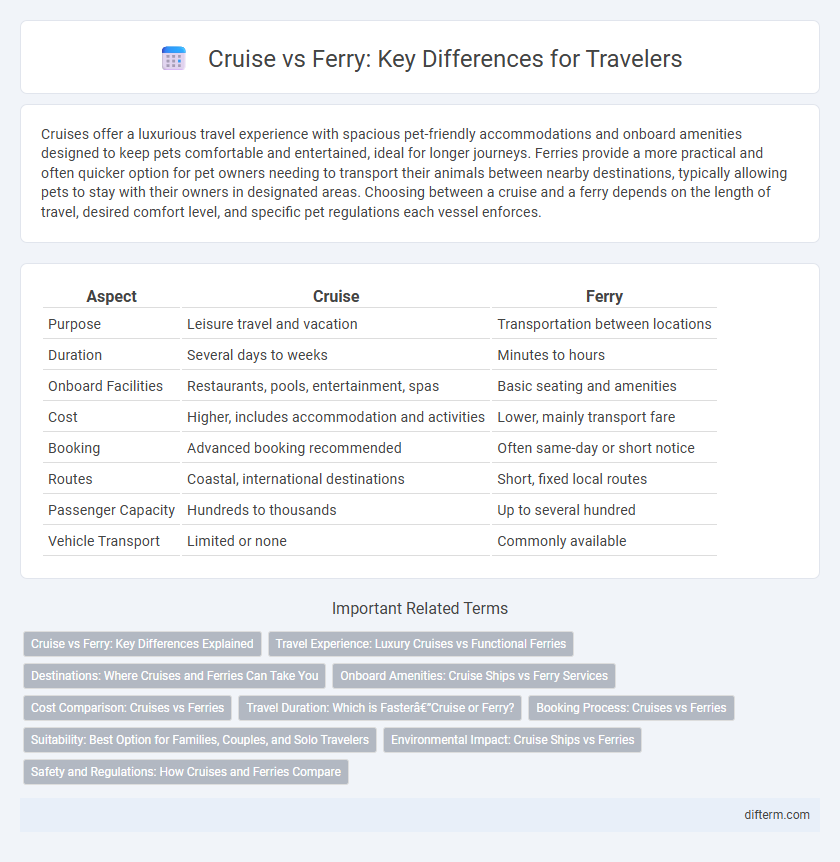Cruises offer a luxurious travel experience with spacious pet-friendly accommodations and onboard amenities designed to keep pets comfortable and entertained, ideal for longer journeys. Ferries provide a more practical and often quicker option for pet owners needing to transport their animals between nearby destinations, typically allowing pets to stay with their owners in designated areas. Choosing between a cruise and a ferry depends on the length of travel, desired comfort level, and specific pet regulations each vessel enforces.
Table of Comparison
| Aspect | Cruise | Ferry |
|---|---|---|
| Purpose | Leisure travel and vacation | Transportation between locations |
| Duration | Several days to weeks | Minutes to hours |
| Onboard Facilities | Restaurants, pools, entertainment, spas | Basic seating and amenities |
| Cost | Higher, includes accommodation and activities | Lower, mainly transport fare |
| Booking | Advanced booking recommended | Often same-day or short notice |
| Routes | Coastal, international destinations | Short, fixed local routes |
| Passenger Capacity | Hundreds to thousands | Up to several hundred |
| Vehicle Transport | Limited or none | Commonly available |
Cruise vs Ferry: Key Differences Explained
Cruises offer luxurious accommodations, onboard entertainment, and multi-day journeys designed for leisure and exploration, often visiting multiple destinations. Ferries primarily serve as practical transportation across short distances, focusing on efficient passenger and vehicle transfer rather than entertainment or amenities. Cruise ships emphasize comfort and experience with amenities like pools, theaters, and fine dining, whereas ferries prioritize speed, frequency, and convenience for daily commuters or travelers.
Travel Experience: Luxury Cruises vs Functional Ferries
Luxury cruises offer an immersive travel experience with spacious accommodations, gourmet dining, and onboard entertainment tailored for relaxation and leisure. Functional ferries prioritize efficient transportation with basic amenities designed to quickly connect destinations, often focusing on cost-effectiveness and practicality. Travelers seeking comfort and indulgence typically choose cruises, while those needing rapid and straightforward transit prefer ferries.
Destinations: Where Cruises and Ferries Can Take You
Cruises often explore multiple international destinations, including exotic islands and waterfront cities like the Caribbean, Mediterranean, and Alaskan coasts, offering diverse cultural experiences and luxury amenities. Ferries primarily serve regional routes, connecting nearby islands or coastal towns such as the Greek Islands, British Isles, or Scandinavian archipelagos, facilitating quick and economical transport. Choosing between a cruise and a ferry depends on whether travelers prioritize extended voyages with onboard entertainment or straightforward transit to specific local destinations.
Onboard Amenities: Cruise Ships vs Ferry Services
Cruise ships offer extensive onboard amenities such as multiple dining options, entertainment venues, swimming pools, and wellness centers, designed to provide a luxurious and immersive travel experience. Ferry services typically provide basic facilities focused on transportation efficiency, including simple seating areas and limited dining choices, prioritizing short-distance travel convenience. The difference in onboard amenities significantly influences passenger comfort and overall travel satisfaction between cruises and ferries.
Cost Comparison: Cruises vs Ferries
Cruises generally involve higher upfront costs due to luxury accommodations, amenities, and entertainment packages, often ranging from $100 to $500+ per day. Ferries offer more economical pricing, typically charging $10 to $50 per trip, focusing primarily on transport rather than leisure activities. Budget-conscious travelers often prefer ferries for short distances, while cruises cater to those seeking a comprehensive travel experience with inclusive services.
Travel Duration: Which is Faster—Cruise or Ferry?
Ferries typically offer shorter travel durations compared to cruises, as they are designed for quick, point-to-point transportation across bodies of water. Cruises prioritize leisurely voyages with multiple stops, extending travel time to enhance the on-board experience. Therefore, travelers seeking speed and efficiency usually prefer ferries, while those aiming for relaxation and entertainment opt for cruises.
Booking Process: Cruises vs Ferries
Booking a cruise typically involves selecting a cabin type, choosing dining and activity packages, and often requires advance reservations through specialized travel agencies or cruise line websites. Ferry bookings are generally simpler, allowing passengers to reserve tickets for specific routes and departure times directly through ferry operator platforms or ticket offices. Cruise reservations demand more detailed planning due to onboard amenities and schedules, whereas ferry bookings prioritize straightforward transportation logistics.
Suitability: Best Option for Families, Couples, and Solo Travelers
Cruises offer an all-inclusive experience with plentiful amenities and entertainment, making them ideal for families seeking diverse activities and couples desiring a romantic getaway. Ferries provide a practical, budget-friendly option suited for solo travelers or those looking for short, scenic transportation between destinations. Families benefit from cruise ships' child-friendly facilities, while solo travelers often appreciate ferries' flexibility and social atmosphere.
Environmental Impact: Cruise Ships vs Ferries
Cruise ships emit significantly higher levels of carbon dioxide and sulfur oxides compared to ferries, due to their larger size and longer travel distances. Ferries generally use less fuel per passenger mile and are increasingly adopting cleaner technologies like electric propulsion and LNG fuel. The environmental impact of ferries is typically lower, making them a more sustainable option for short-distance water travel.
Safety and Regulations: How Cruises and Ferries Compare
Cruises adhere to stringent international maritime safety regulations such as SOLAS, incorporating advanced emergency protocols, trained crew, and regular inspections, which often exceed those of ferries. Ferries operate under regional safety standards that vary by country but generally include mandatory life-saving equipment and routine safety drills tailored for shorter routes. Passenger safety on cruises is enhanced by comprehensive onboard medical facilities and advanced navigation technology, while ferries prioritize quick evacuation procedures suited to frequent, short-distance travel.
cruise vs ferry Infographic

 difterm.com
difterm.com